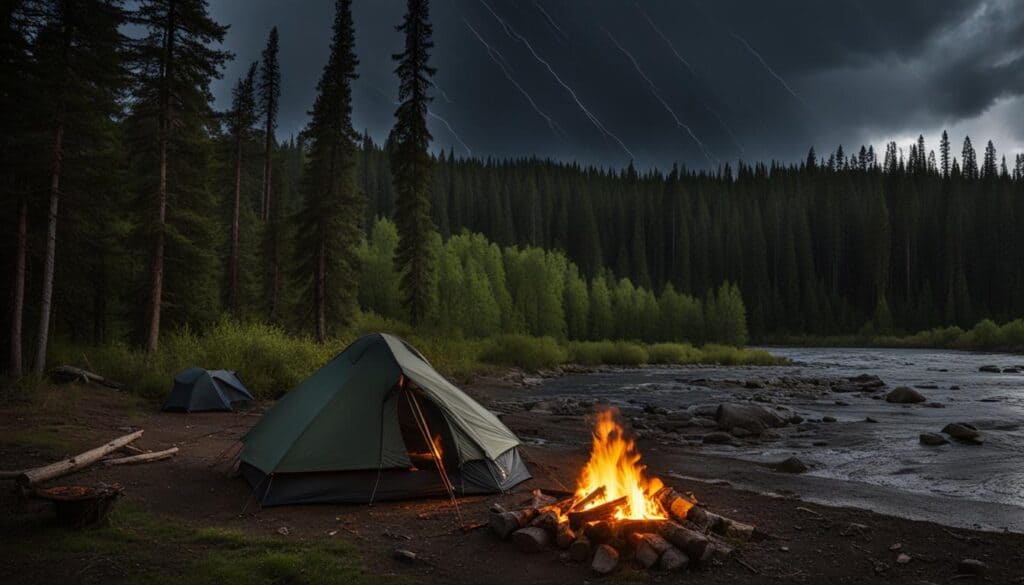Camping in a thunderstorm can be both safe and thrilling. While there are risks involved, it is possible to have an unforgettable experience while staying safe. This comprehensive guide will provide practical tips for camping during a thunderstorm, debunk common myths, and offer essential safety precautions. It’s important to understand the potential dangers and take necessary precautions to ensure a safe and enjoyable camping experience.
Topics We Will Cover:
- Prepare for camping in a thunderstorm by selecting the right gear and understanding the risks involved.
- Debunk the myth that tents provide sufficient protection from lightning.
- Choose a safe camping location, anchor your tent properly, and avoid tall trees or mountains.
- Pack essential gear and have emergency plans in place for thunderstorm camping.
- Follow safety precautions when hammock camping in a thunderstorm and consider the advantages and disadvantages compared to tent camping.
Understanding the Risks of Camping in Thunderstorms
Camping in thunderstorms can be an exhilarating outdoor adventure, but it’s crucial to stay secure and be prepared for the potential risks. Thunderstorms bring unpredictable weather conditions, including heavy rain, strong winds, and lightning, which can pose serious threats to campers. To have a nature escape while ensuring your safety, it’s essential to understand the risks and practice weather resilience strategies.
One of the primary risks during a thunderstorm is lightning. In the United States, lightning is responsible for an average of 20 deaths and over 300 injuries per year. It’s important to recognize that lightning can strike from a distance, even when the storm seems far away. Avoiding tall objects, such as trees and metal structures, and seeking shelter in a solid building or a vehicle are recommended precautions. Additionally, being cautious of flash flooding, strong winds, and falling trees is crucial to stay safe during a thunderstorm camping trip.
“Understanding the risks involved in camping during a thunderstorm allows campers to make informed decisions and take necessary precautions to ensure their safety.”
Preparing for Thunderstorm Camping
Before heading out on a camping trip during thunderstorm-prone weather, it’s important to check the weather forecast and assess the risk level. Pack essential camping gear such as a first aid kit, high-quality rain gear, waterproof tent or hammock, and reliable lighting options. It’s also advisable to have an emergency plan in place, including knowing where the nearest shelter is and how to quickly seek safety if a thunderstorm approaches.
When camping in a tent, selecting the right tent and location is crucial. Choose a tent that is specifically designed to withstand bad weather camping, with sturdy construction and a full-coverage rain fly. Look for a safe camping location that is lower in elevation, away from tall trees or mountains, and with shorter vegetation. Properly anchoring the tent with stakes and guylines and keeping gear away from the tent walls can prevent damage and moisture leaks.
By understanding the risks, preparing adequately, and being aware of your surroundings, you can embark on a thunderstorm camping adventure with confidence, ensuring a safe and memorable experience in the great outdoors.
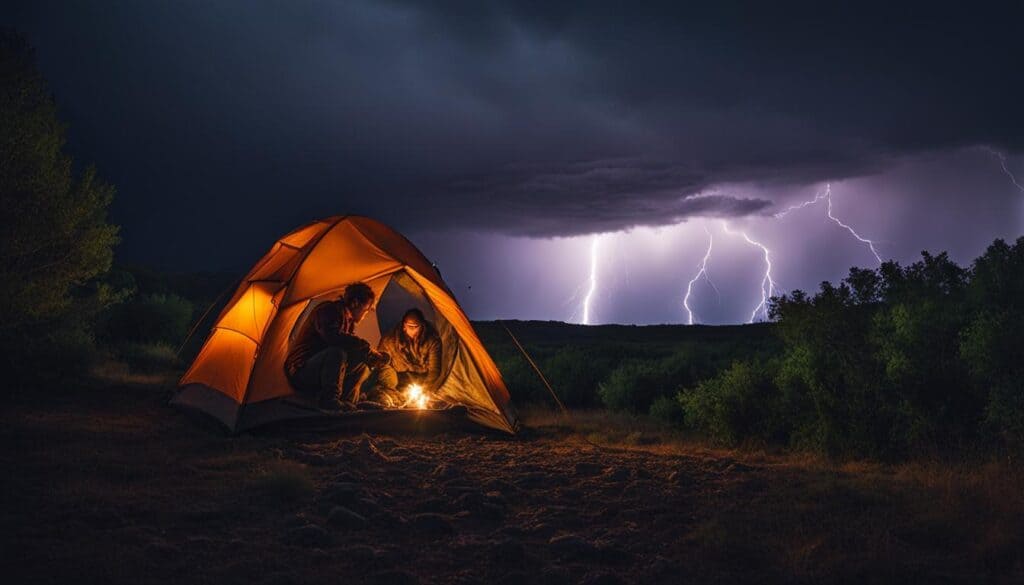
Debunking Myths about Tents and Lightning
When it comes to camping in a thunderstorm, there is a common misconception that tents provide safety from lightning. However, this is a myth that needs to be debunked. Most tents, particularly those made from fabric and supported by aluminum poles, are not designed to withstand a direct lightning strike.
It’s crucial to understand that tents do not offer adequate protection from lightning. Additional precautions must be taken to ensure safety while camping in a thunderstorm. Investing in a tent designed for stormy weather and understanding lightning protection measures are essential.
Table: Comparing Lightning Protection Features of Tents
| Tent Type | Lightning Protection |
|---|---|
| Fabric tents with aluminum poles | No protection against lightning |
| Tents with built-in lightning rods | Provides some level of protection |
| Specialized lightning-proof tents | Offers the highest level of protection |
It’s important to choose a tent that is specifically designed for stormy weather. These tents often come with built-in lightning rods or other lightning protection features. They are made from materials that can withstand extreme weather conditions, including lightning strikes. By investing in a tent that prioritizes safety in thunderstorms, campers can significantly reduce the risk of lightning-related accidents.
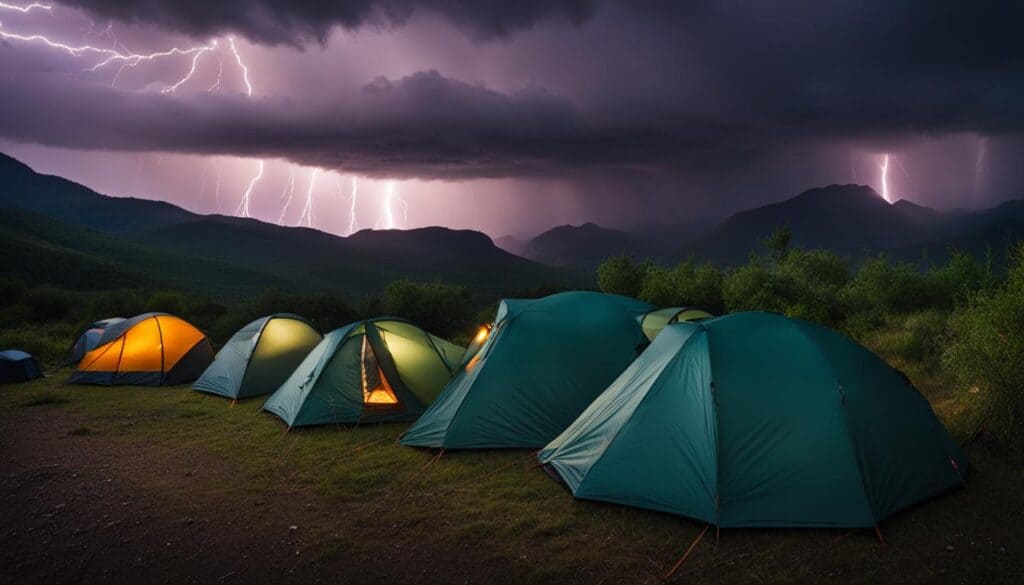
Preparing for a Thunderstorm: Tent Selection, Location, and Set-Up
When camping in a thunderstorm, it is crucial to make the right preparations. This includes selecting a tent designed for stormy weather, choosing a safe camping location, and properly setting up the tent. Investing in a double-wall tent with a full-coverage rain fly, strong pole system, and mesh ventilation can help withstand thunderstorm conditions.
Choosing a lower area with shorter vegetation and avoiding tall trees or mountains can reduce the risk of lightning strikes. Anchoring the tent with stakes and guylines and keeping gear away from the tent walls can prevent damage and moisture leaks.
Here is a table summarizing the key considerations for tent selection, location, and set-up:
| Consideration | Precaution |
|---|---|
| Tent Selection | Choose a double-wall tent with a full-coverage rain fly, strong pole system, and mesh ventilation. |
| Location | Select a lower area with shorter vegetation, and avoid tall trees or mountains. |
| Set-Up | Anchoring the tent with stakes and guylines and keeping gear away from the tent walls can prevent damage and moisture leaks. |
By following these precautions, you can increase your safety and minimize the risks associated with camping in a thunderstorm. Remember to always check weather forecasts before your trip and be prepared to adjust your plans if necessary.
Essential Gear and Emergency Plans for Thunderstorm Camping
When camping in a thunderstorm, it is crucial to have the right gear and emergency plans in place to ensure your safety. Packing the essential camping gear can make all the difference during severe weather conditions. Here are some items you should include in your camping gear checklist:
- A high-quality rain jacket and waterproof pants to keep you dry even in heavy downpours.
- A sturdy and waterproof tent that can withstand strong winds and prevent leaks.
- A reliable lighting source such as a headlamp or lantern to provide visibility during dark stormy nights.
- An emergency whistle and signal mirror to attract attention in case of emergencies.
- A first aid kit stocked with essential medical supplies to treat any minor injuries.
- A portable weather radio or a fully charged cell phone to stay informed about the weather conditions.
In addition to having the right gear, it’s crucial to have an emergency plan in place. Here are some important steps to consider:
- Monitor the weather forecast before your camping trip and be prepared to change or cancel your plans if severe weather is expected.
- Identify nearby shelters or safe structures where you can seek refuge in case of lightning or other hazardous conditions.
- Share your camping itinerary and emergency contact information with a trusted friend or family member.
- Establish a communication plan with your camping group in case you get separated during a storm.
- Designate a safe meeting point and establish a procedure for emergency evacuation if necessary.
By ensuring you have the right gear and emergency plans in place, you can stay safe and enjoy your camping experience even during a thunderstorm.
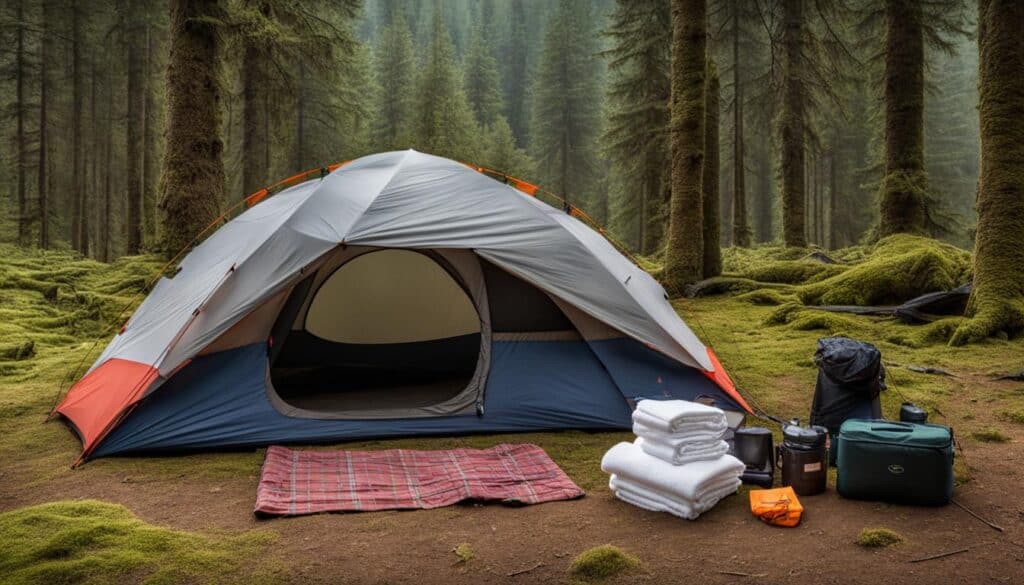
For More Information On This Topic Read This Article: Ultimate Guide To Camping In The Rain
Comparing Hammock Camping and Tent Camping in Thunderstorms
When it comes to camping in thunderstorms, both hammock camping and tent camping have their own safety considerations. It’s important to understand the advantages and disadvantages of each option to make an informed decision and ensure a safe camping experience.
Hammock Camping
Hammock camping can be a viable alternative to tent camping during a thunderstorm. Being suspended off the ground can provide an advantage if there is a risk of flooding. However, there are specific safety considerations to keep in mind.
- Choose a safe location away from tall trees, bodies of water, and high ground. This will reduce the risk of lightning strikes and falling branches.
- Use a hammock system without metal components, as metal can attract lightning.
- Invest in a high-quality rain tarp to protect against rain and wind.
By following these precautions, you can minimize the risks associated with hammock camping in a thunderstorm and enjoy a safe outdoor experience. Remember to always stay informed about the weather and be prepared to seek shelter if conditions worsen.
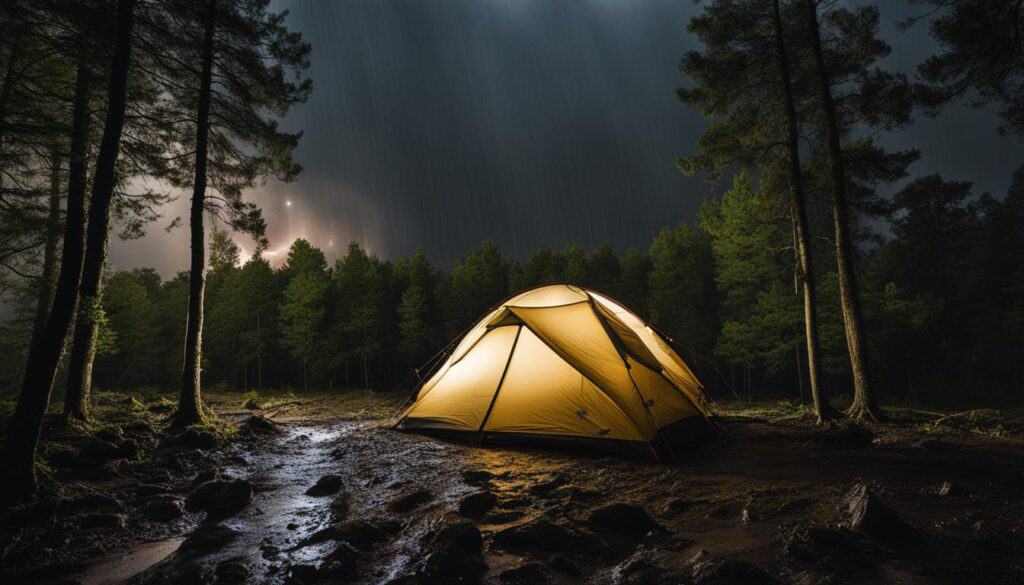
Tent Camping
Tent camping provides a different set of safety considerations in thunderstorms. While being on the ground can offer some protection from lightning strikes, there are other factors to consider:
- Choose a safe camping location that is lower in elevation, away from tall trees, and avoids areas prone to flooding.
- Ensure your tent is made of durable materials and designed to withstand stormy weather.
- Properly anchor and secure your tent to prevent damage from strong winds.
By following these safety considerations for tent camping, campers can enjoy the experience while minimizing the risks associated with thunderstorms.
Conclusion
Both hammock camping and tent camping have their own safety considerations when it comes to thunderstorms. Ultimately, the decision between the two will depend on individual preferences and the specific camping situation. By understanding the risks and taking necessary precautions, campers can have a safe and enjoyable outdoor experience, regardless of the camping style chosen.
| Tent Camping | Hammock Camping | |
|---|---|---|
| Advantages | Provides some protection from lightning strikes. | Allows you to be suspended off the ground, reducing the risk of flooding. |
| Disadvantages | Makes you more susceptible to ground currents and flooding. | Requires careful tree selection and non-metallic suspension systems to reduce the risk of lightning strikes. |
| Safety Precautions | Choose a safe camping location away from tall trees and keep gear away from the tent walls. | Choose a safe location away from tall trees, bodies of water, and high ground. Use non-metallic suspension systems and have a good rain tarp. |
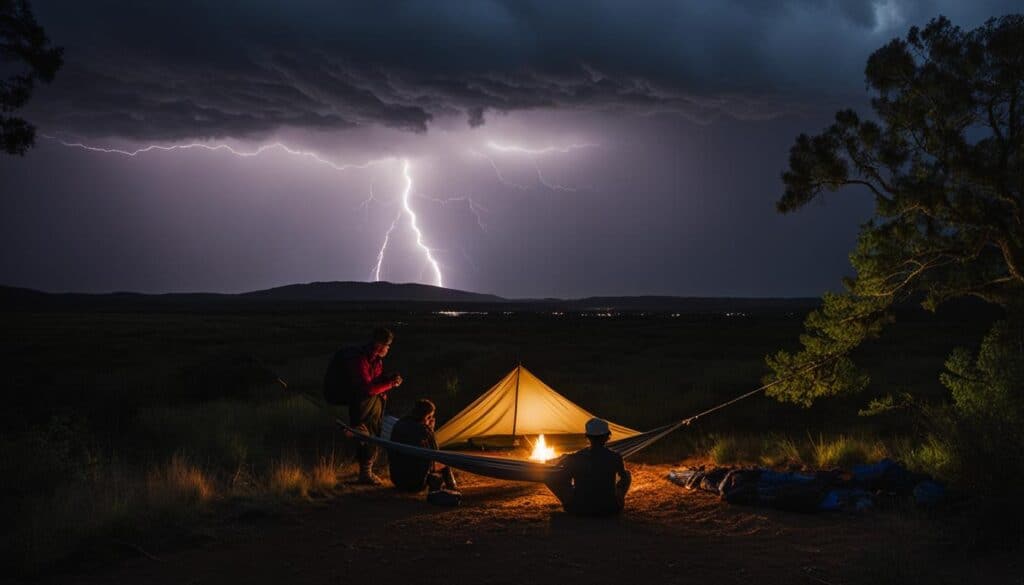
Safety Precautions for Hammock Camping in a Thunderstorm
When planning a hammock camping trip during a thunderstorm, it is crucial to prioritize safety and take necessary precautions. By following these guidelines, you can minimize risks and ensure a safe and enjoyable experience.
1. Choose a safe location: Select a campsite that is away from tall trees and bodies of water. This reduces the risk of lightning strikes and keeps you safe from falling branches or debris caused by strong winds.
2. Use non-metallic suspension straps: Metal can attract lightning, so it is important to use suspension straps made from non-conductive materials. This helps reduce the risk of a lightning strike during a thunderstorm.
3. Invest in a high-quality rainfly: A rainfly is essential for protecting you from rain and wind during a thunderstorm. Choose a rainfly that provides full coverage and is made from durable, waterproof material.
4. Stay informed about the weather: Keep an eye on the weather forecast before and during your camping trip. If severe weather is predicted, consider changing your plans and seeking shelter in a safe structure or vehicle.
Remember, safety should always be your top priority when hammock camping in a thunderstorm. By following these precautions and staying vigilant, you can have a safe and enjoyable camping experience.
Table: Hammock Camping Precautions in Thunderstorms
| Precautions | Explanation |
|---|---|
| Choose safe trees | Select healthy and sturdy trees that are not the tallest in the area to reduce the risk of lightning strikes. |
| Use non-metallic suspension systems | Avoid using metal components in your hammock setup to minimize the chances of attracting lightning. |
| Invest in a high-quality rainfly | Ensure that your hammock setup includes a rainfly that provides adequate protection from heavy rain and wind. |
| Stay informed about the weather | Monitor weather forecasts and be prepared to seek shelter in a solid structure or vehicle if a severe thunderstorm is approaching. |
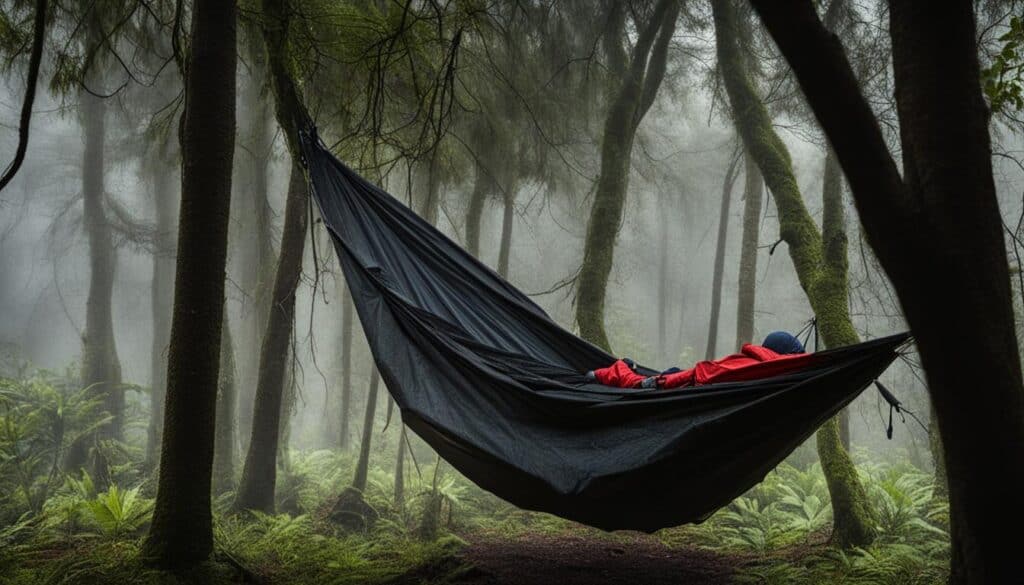
Unique Considerations for Hammock Camping in Thunderstorms
Hammock camping in a thunderstorm requires careful consideration of the campsite location and gear choices. While hammocks offer certain advantages, such as being suspended off the ground and minimizing the risk of flooding, there are unique considerations to keep in mind to ensure a safe experience.
First, it is important to choose trees that are less likely to attract lightning. Look for healthy and sturdy trees that are not the tallest in the area. Avoid camping near bodies of water or on high ground, as these can increase the risk of lightning strikes. Additionally, using non-metallic suspension systems is crucial to reduce the chances of attracting lightning.
To further protect yourself during a thunderstorm, it is essential to have a high-quality rainfly for your hammock. This will provide you with additional shelter from heavy rain and wind. Ensure that the rainfly is securely attached to your hammock setup and properly angled to prevent water from pooling on top.
Staying informed about the weather conditions is also vital. Keep an eye on weather forecasts and be prepared to change your plans if necessary. If a severe thunderstorm is approaching, it may be safer to seek shelter in a solid structure or vehicle instead of staying in your hammock.
Table: Hammock Camping Precautions in Thunderstorms
| Precautions | Explanation |
|---|---|
| Choose safe trees | Select healthy and sturdy trees that are not the tallest in the area to reduce the risk of lightning strikes. |
| Use non-metallic suspension systems | Avoid using metal components in your hammock setup to minimize the chances of attracting lightning. |
| Invest in a high-quality rainfly | Ensure that your hammock setup includes a rainfly that provides adequate protection from heavy rain and wind. |
| Stay informed about the weather | Monitor weather forecasts and be prepared to seek shelter in a solid structure or vehicle if a severe thunderstorm is approaching. |
By understanding these unique considerations and taking necessary precautions, you can have a safe and enjoyable hammock camping experience even during a thunderstorm.

Conclusion
Camping in a thunderstorm can be both a thrilling and safe experience if proper precautions are taken. Understanding the risks and debunking common myths about camping in stormy weather is essential. By selecting the right gear, such as a storm-ready tent or hammock, and choosing a safe camping location away from tall trees and bodies of water, campers can minimize the dangers associated with thunderstorms.
It is important to have essential camping gear, including high-quality rain gear and reliable lighting options, and to have an emergency plan in place. Staying informed about the weather and being prepared to change plans if necessary is crucial for safety. Whether opting for tent camping or hammock camping, prioritizing safety and respecting the power of nature can ensure a memorable and secure camping experience.
In conclusion, camping in a thunderstorm requires careful preparation and a knowledge of safety measures. By following the guidelines outlined in this article, campers can enjoy the beauty of nature even during thunderstorms while prioritizing their safety. So, don’t let a thunderstorm dampen your spirit, be well-prepared, and embrace the adventure!
FAQ
Is camping in a thunderstorm safe?
Camping in a thunderstorm can be safe if proper precautions are taken. Understanding the risks, selecting appropriate gear, and having emergency plans in place are crucial for a safe camping experience.
Are tents safe from lightning?
Most tents do not offer adequate protection from lightning. Tents made from fabric and supported by aluminum poles are not designed to withstand a direct lightning strike. Additional precautions must be taken to ensure safety while camping in a thunderstorm.
How do I select a safe camping location during a thunderstorm?
Choosing a lower area with shorter vegetation and avoiding tall trees or mountains can reduce the risk of lightning strikes. It is important to select a location away from bodies of water and open spaces.
What gear should I pack for camping in a thunderstorm?
Essential gear for camping in a thunderstorm includes high-quality rain gear, a waterproof tent, reliable lighting options, and a first aid kit. It is also important to have a portable weather radio for updates on the storm.
What should I do if a thunderstorm approaches while camping?
If a severe thunderstorm approaches while camping, it is important to seek shelter in a solid structure or vehicle. Avoid open areas, tall objects, and bodies of water. Stay informed about the weather and be prepared to change plans if necessary.
How can I protect myself while hammock camping in a thunderstorm?
When hammock camping in a thunderstorm, it is important to choose a safe location away from tall trees, bodies of water, and high ground. Use a hammock system without metal and ensure you have a good rain tarp for protection against rain and wind.

